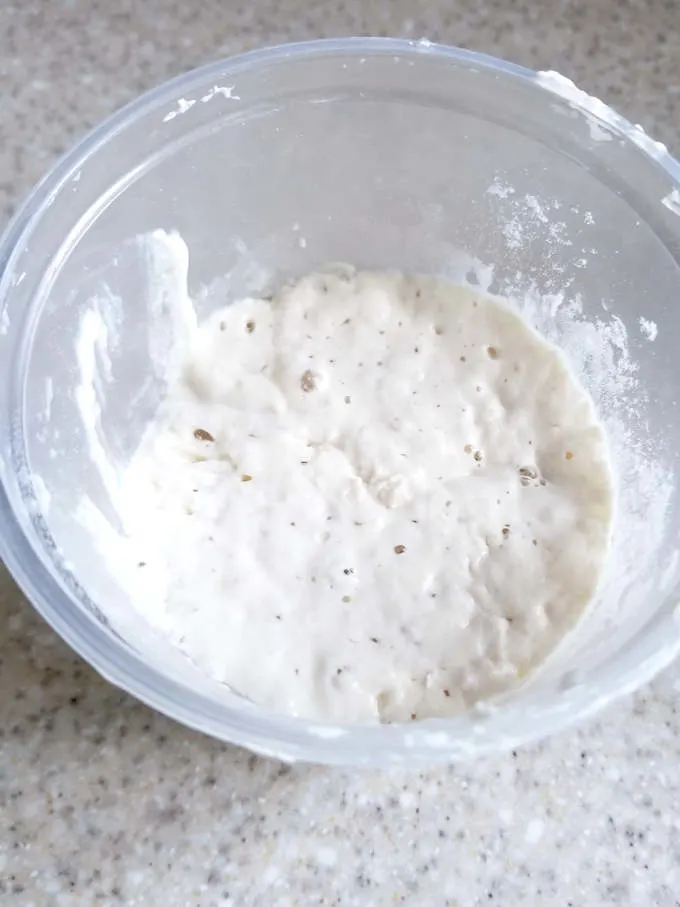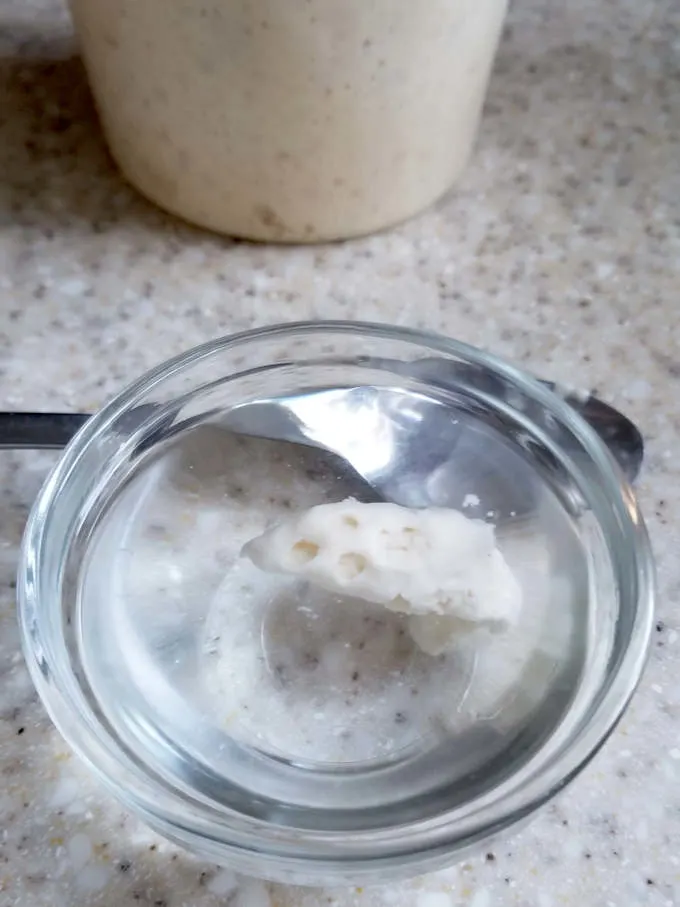Sourdough Croissants
These Sourdough Croissants are the best croissants ever! To have fresh Sourdough Croissants for breakfast, refrigerate them overnight and bake in the morning.

The difference between Classic Croissants and Sourdough Croissants is the use of the natural yeast in the starter to rise the dough. (You can use a smidge of commercial yeast to help you out, more on that later.)
If you don’t have one, check out my post to learn How to Make a Sourdough Starter. Then check out my system to Feed and Maintain Sourdough Starter. In the meantime you can go ahead and make those Classic Croissants with yeast.
I baked over 100 Sourdough Croissants before I was ready to post the recipe. The basic ingredients were not hard to nail down, I simply replaced some of the water and flour in the dough with sourdough starter and removed the yeast.


The biggest hurdle was keeping the dough warm enough to stay active, but not so warm that the buttery layers melt out of the dough. Well, that’s the challenge with any croissant recipe, but when working with sourdough is even more of a challenge.

What’s the secret to great Sourdough Croissants?
After several less than stellar batches, I finally decided that I had to treat this dough differently than classic croissant dough. Normally I would chill the dough after it’s mixed and chill it between each “turn”.
The problem with using that classic method is that each time I refrigerated the dough I slowed down the activity of the natural yeast and I could never get quite the poof I wanted in the final rise.
The first change I made was to add a hint of commercial yeast to the dough. Just a 1/2 teaspoon to help the dough stay active, but not so much that it would overtake the natural yeast or speed up the process too much. ***(See recipe note to make the recipe without commercial yeast.)
After 3 hours of fermentation the dough was beautifully soft, yet resilient. So I decided to skip the refrigeration step and move right into the lamination process.
Because the dough was soft, I let the butter warm up enough that it was a bit pliable, but still cool. This made it easier to roll the dough without the butter breaking apart.
Since the dough was so easy to work with I went right ahead and did the first two turns. I gave the dough a quick chill before the final turn and then a longer chill before rolling and cutting the dough.
Not only did this process cut a couple of hours from the total time, it also meant that my dough stayed nicely active. The dough was silky and alive. A good sourdough should feel alive in your hands.
The final step was to refrigerate the croissants overnight. In the morning I got up super early (the dogs help me here) and took the croissants out of the refrigerator.
Because my kitchen can be quite cool on a winter morning, I turned the oven on just for a minute to barely warm it up then turned it back off. (I wouldn’t need to do this in the summer.)
I put the trays in the oven and went back to bed (I’m not a morning person). When I got up a few hours later the croissants were ready to bake as soon as the oven was preheated.


Tips for making Sourdough Croissants:
- Your sourdough starter should be active when you mix the dough. It should pass the “float test”. Put a dollop of the active starter in water and it should float. If not, replenish your starter and wait until it’s active to mix the dough.
- If your kitchen is very cool, place the dough over a bowl of warm water or into a barely warmed oven during the fermentation time.
- If you find the butter is melting at any point during the lamination process, put in the the refrigerator briefly to chill.
- Brushing the dough with cool water before each fold helps create steam as the croissants bake. The steam will push the layers even higher for a bigger rise and flakier texture.
- The times in the recipe are estimates. The actual times will vary based on how active your starter is and the ambient temperature. The times will also be longer if you choose not to use the commercial yeast.

Over 100 croissants later, I can tell you that Sourdough Croissants have a depth of flavor that sets them apart from those made with commercial yeast. If you have a sourdough starter, I’m sure you know what I mean.
I know you hate to throw away that sourdough discard. Check out these recipes that use sourdough discard.
Are you a chocoholic? Me too. Use this dough to make decadent and delicious Chocolate Croissants. You’re welcome!
I’ve also got a recipe for almond lovers, Almond Filled Croissants are a little decadent and a lot delicious.
If you love this recipe as much as I do, I’d really appreciate a 5-star review.
Overnight Sourdough Croissants
Video
Ingredients
- 8 oz active sourdough starter (1 cup, 100% hydration)
- 10 oz whole milk (1 ¼ cups, scalded and cooled to 110 °F)
- ½ teaspoon dry yeast (optional, see note)
- 17 ½ oz unbleached all purpose flour (3 ½ cups, see note)
- 3 oz granulated sugar (⅓ cup)
- 2 teaspoons table salt
- 16 oz unsalted butter (pliable but still cool)
- 1 egg (for egg wash)
Instructions
- Make sure your starter is active and bubbly before using. If not, refresh the starter and wait until it's fully active before mixing the dough. Place 8 oz active sourdough starter, 10 oz whole milk, ½ teaspoon dry yeast (if using) and 2 cups (10 oz) of the flour in the bowl of a stand mixer with the paddle attachment. Mix to form a thick batter. If working by hand mix with a wooden spoon. Cover the bowl and let it rest for 30 minutes.
- Switch to the dough hook. Add 3 oz granulated sugar, 2 teaspoons table salt and remaining flour. Mix until the dough gathers on the hook and clears the sides of the bow, about 3-5 minutes on medium speed. l. If working by hand stir in as much flour as you can with a wooden spoon, then finish kneading in the rest of the flour by hand.
- Transfer the dough to a lightly oiled bowl, turning once to coat the dough. Cover the bowl and set it aside at room temperature. After 30 minutes uncover the bowl, lift one side of the dough over into the middle of the dough. Repeat with the other three sides of the dough then flip the dough over. Cover the bowl and after 30 minutes repeat the procedure. Cover the bowl and after 60 minutes repeat the procedure. Cover the bowl and after 60 minutes repeat the procedure one last time. By now the dough should be lively, elastic and airy. If the dough is still sluggish give it another hour or two at room temperature.
- While the dough is fermenting, prepare the butter package. Draw an 8" square in the center of a piece of parchment paper. Flip the paper over and set 16 oz unsalted butter in the middle of the square. Fold the parchment over the butter. Use a rolling pin or other heavy object (I use the flat side of a meat tenderizer) to flatten the butter to fill the 8"x 8" square. You can lift the paper if it sticks. Trim and rearrange the edges of the butter as needed. Fold the butter into the parchment and place in the refrigerator. 30 minutes before the dough is finished fermenting, remove the butter from the refrigerator. (If your kitchen is very warm, take the butter out 10 minutes ahead.) The butter should be firm and cool but a little flexible for layering into the dough.
- Turn the dough out onto a lightly floured surface. Do not knead out the air. Roll the dough to a 10" square. Once you have a square, roll from each of the four sides to form a 3" flap of the dough, leaving the center thicker than the flaps. You should end up with a square with four "flaps" coming out from the corners. Now it’s time to layer in the butter.
- Unwrap the butter and place it in the middle of the square. Fold the flaps so they overlap and enclose the butter, pinching in the corners as necessary to glue the seams together. You should now have an 8" square of dough with the butter enclosed. Use the rolling pin to gently press on the square to flatten it. Roll the dough to a 8" x 24" rectangle. Take your time to roll gently and evenly so the butter stays in one layer in the dough.
- Orient the dough so the long side of the rectangle is facing you. Brush off the excess flour. Brush the entire surface of the dough with cold water. Fold the right 1/3 of the dough towards the middle then fold the left 1/3 of dough over enclosing it like a letter. This is the first "turn".
- Orient the dough so the closed edge is on the top side and the open edge is facing you. Roll the dough again to an 8" x 24" rectangle. Brush off the excess flour. Brush the entire surface of the dough with cold water and again fold the dough like a letter. This is the second "turn". Set the dough on a sheet pan, cover with plastic and refrigerate at least 30 minutes.
- Remove the dough from the refrigerator and do a third turn exactly like the first 2. Wrap the dough and place it in the refrigerator for at least 2 hours.
- Line 2 baking sheets with parchment paper or a silicone baking mat. Roll the chilled dough to a 24” long x 16” wide rectangle. With the long side facing you, fold the top half of the dough over the bottom half to form a 24” long x 8” wide rectangle.
- Starting from the left, measure along the top edge of the dough and make a mark at 2”. Using a pizza cutter or sharp knife, make a diagonal cut from that mark to the bottom left edge of the dough. Save the piece that you cut off.
- Working from left to right, measure and mark 4” increments along the bottom edge of the dough. Working from left to right, measure and mark 4” increments along the top edge of the dough. You should have a pattern of one top mark between two bottom marks. Starting from the top left, make a diagonal cut to the next mark on the bottom edge, forming a triangle. Then cut from the bottom to the next top mark. Continue this pattern to cut 11 alternating triangles and one 1/2 triangle end piece. Save the 1/2 triangle piece you cut from the end of the dough.
- Unfold the triangles and cut each in half along the joint so you have a total 22 triangles. Unfold the 1/2 triangle pieces which you cut from either end. Pinch them together to form 2 more triangles.
- To form a croissant, hold a triangle from the wide base in one hand and gently stretch the width a little. Set the dough on the work surface with the narrow end pointing towards you. Roll the croissant towards the pointed end, holding on to the tip and gently tugging as you roll. Bend either end of the croissant towards the middle to form the crescent shape.
- Set the croissants on the prepared baking sheets, 3” apart. You should fit a dozen croissants per half sheet pan. Cover with plastic wrap and set in the refrigerator overnight. (see note)
- In the morning. Take the croissants out of the refrigerator. Allow them to proof at room temperature for 2-3 hours. The exact time needed for proofing will vary depending how active your starter was and the temperature of your kitchen. They should be at least 50% larger than they started and feel airy and puffy. Preheat the oven to 400 °F. Brush the croissants with egg wash. Bake the croissants until golden brown, 15-20 minutes. Serve warm or room temperature.
Would you like to save this recipe?
As an Amazon Associate and member of other affiliate programs, I earn from qualifying purchases.









Hello Eileen,
I have only recently been experimenting with sourdough recipes.
The problem I had was that the croissant collapsed after coming out of the oven. Still taste good though
A lot of butter oozed out during cooking and they feel quite heavy and doughy..
Any suggestions?
Many thanks
Sandra (UK)
It’s possible that your dough was not properly fermented. If you scroll through the post and look at the photos you’ll see a photo showing side-by-side comparison of under-ermented and properly fermented dough.
Hi eileen, I cannot seem to find your video on making sourdough croissants on your page. Can you assist? I am feeling challenged following through the instructions from step 4 onwards and would very much appreciate a video to guide me through. Thank you! 🙂
If you’re running an ad blocker the video won’t play. If you turn off the ad blocker the video player will show.
I tried these today, but they didn’t quite turn out right. The flavor was great, but I didn’t wait long enough for the final rise, after taking them out of the fridge, so that was my fault. My dough did great, rise-wise, throughout the entire process prior to that…it was nice and billowy and soft, yet resistant. I also used bread flour instead of all purpose. Do you think that would effect things. Or, was more simply because I was impatient when it came to the final rise? They didn’t really double, and I could tell with the result that I messed up by not waiting longer =( Anyway, I’m still wondering if you think using bread flour would work, if I actually did what I was supposed to and waited for the proper rise at the end 😉
Also, when I did the laminated, the butter didn’t exactly melt; but, it did soften some and ooze out the edges of the dough a little when I was rolling it into a rectangle. Is that supposed to happen?
The biggest difference with bread flour is not only that you’ll get more gluten, but bread flour also absorbs more moisture so the dough will be drier. That being said, using bread flour shouldn’t ruin the croissants. It probably made the dough harder to roll since it will tend to spring back more. It also may make it hard to keep the butter in if the dough wants to continually snap back.
I will say that having made these croissant many times, that final rise can seem to take forever. I set the alarm for super-early, like 4 or 5 am, take them out of the fridge and go back to bed for a few hours. I’ve had some readers tell me they’ve been leaving their recipes out on the counter overnight rather than in the fridge. If your kitchen is cool that can work. That might be a problem in the warmer months.
If your butter softened and oozed during the laminating process that could compromise the layers as the croissants bake. (Combined with extra spingy dough too.) As I mention in the “tips” section of the post, if the butter softens at any time return the dough to the fridge to chill before proceeding. The butter should be slightly pliable but still cool when you start the process.
What did the final croissants look like? Were then just a little under-risen or did they not have all the distinct layers inside? My feeling is that the oozing butter may have been your biggest issue.
Hi!! Is it possible to not use osmotolerant instant yeast?? just WILD YEAST from the STARTER??? 🙂 or what should I use instead?
You can make the dough without commercial yeast, you’ll just have to be patient with the fermentation and rising times. Make the dough when your starter is really active to give it a head start. I haven’t made these recently, but I need to give them another try without commercial yeast to nail down the timing. If you try it, let us know how it goes.
Edited to add: I just made this recipe again without any commercial yeast, and it worked just fine. I’ll update the post with details, but you do just have to be a bit more patient, especially with the long fermentation on the first day. It also took a bit longer for the croissant to rise in the morning, but it is workable. Thanks for spurring me on to continue working on the recipe!
Hi Eileen! I made these last week and they were awesome! I froze half the batch and want to make them this weekend. Is it better to take them out the day before and defrost them in the fridge or take them out the night before and defrost them at room temperature so they’re ready to bake in the morning? Love your recipes! Thanks.
I would take them out and defrost them at room temp. I find that if something is frozen solid they don’t quite defrost in the fridge overnight. Let me know how they do. I usually freeze them after baking.
Hi Eileen
Quick question as I’m going to make these today, in your notes below the recipe you talk about freezing before baking then defrosting, proving and baking. But in your comment above you say you bake then freeze. Which do you recommend?
I’ve done both. Personally, I prefer to bake them and then freeze for the convenience. As long as you give them a couple of minutes in the oven to warm up there as good as fresh-baked.
Hi Eileen,
Thank you so much for sharing this recipe. I’m from Brazil, and here we use celsius to measure temperature. So, when you say 110° for the milk, is it in Farenheit ou Celsius?
Thanks again
Hi Carolina, all the temperatures listed in my recipes are Fahrenheit. Thanks for asking.